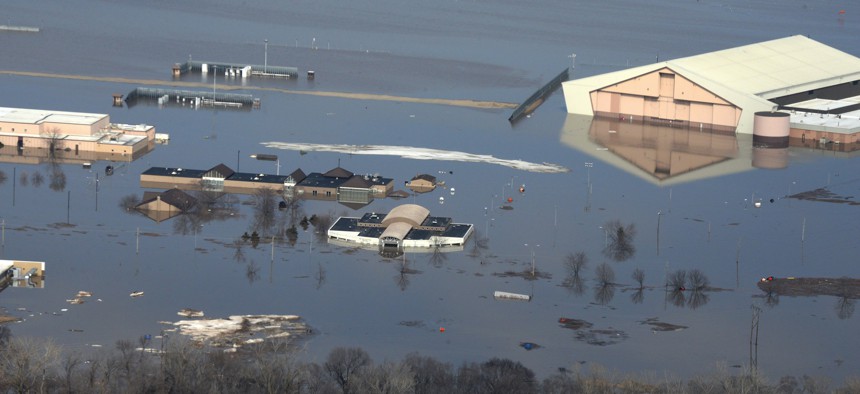
Water covered one-third of Offutt Air Force Base, Nebraska, after the Missouri River flooded in March 2019. U.S. Air Force / Tech. Sgt. Rachelle Blake
What Would a Climate-Focused DoD Budget Look Like?
It’d be less about what we spend and more about how we spend the money we already have.
President-elect Joe Biden has said that he has no plans for major defense budget cuts. At the same time, House Armed Services Committee Chairman Adam Smith, D-Washington, has indicated that he expects progressive members would be prepared to fight for reductions. As a way to thread this needle, some observers have speculated that rather than cuts, there may be a greater emphasis on COVID or climate change impacts within the defense budget.
What would a greater emphasis on climate change in the budget look like?
It’s complicated. There’s no “climate change” line item in the budget, and there’s a lot one can do to take the security threats from climate change seriously without moving money around. A climate-focused DoD budget is at least as much about how you spend the money you were already planning to spend as it is about spending new money.
One possible blueprint emerged last year. The Climate Security Plan for America provides dozens of recommendations on how to address climate security challenges in the years ahead. It is the work of the Climate and Security Advisory Group, whose dozens of security experts include a former Chief of Staff of the Army, a former Chief of Staff of the Air Force, and six other retired four-stars..
One item that stands out is the recommendation to create a Climate Security Infrastructure Initiative to bolster the climate resilience of critical civilian and military infrastructure.
The need should come as no surprise to those who watched hurricanes devastate Tyndall Air Force Base and Camp Lejeune, or who saw floods submerge a third of Offutt Air Force Base, which hosts U.S. Strategic Command. These disasters imposed recovery costs in the billions of dollars.
The Defense Department has long recognized sea-level rise trends in Norfolk and other coastal installations. It wrestles with the threat of wildfires to bases in California; in August, it evacuated Travis Air Force Base as flames drew near. Bases in Alaska are threatened by permafrost thaw.
Initial investments might be focused at the installations the Army, Navy and Air Force identified last year as the ones most vulnerable to climate impacts. Of note, more than half of the Air Force’s most vulnerable installations were in Florida.
These funds might require higher military construction budgets, which were slashed by 59 percent in this year’s budget request, but it’s easy to argue that these investments would improve the military’s readiness, especially when the National Defense Strategy argues that the homeland is no longer a sanctuary.
The Climate Security Plan for America also identified the importance of energy resilience programs and natural resilience to protect DoD training and testing ranges, so it would be reasonable to foresee increases in programs such as the Energy Resilience and Conservation Investment Program and the Readiness and Environmental Protection Integration Program. It highlighted the need to develop resilience plans at every DoD base – a requirement recently enacted by Congress – but planning dollars are in the noise of the DoD budget.
A budget that focused more on climate change might increase funding for research on the effects on DoD, such as the discovery that rising seas will in coming decades force humans to leave Kwajalein Atoll in the Marshall Islands, host to a sophisticated and very expensive military radar installation.
Many people think of a climate-focused budget as one that will be full of “green” initiatives designed to reduce emissions. However, many such efforts – such as energy efficiency investments or renewable energy installations – can pay for themselves or yield resilience benefits more significant than their prospective emissions reductions. In other words, there are other reasons to fix a hole in the roof than reducing emissions or increasing energy efficiency. In addition, there have been proposals to use the buying power of the Federal government to increase purchase electric vehicles, but this is again more of a choice on what types of vehicles to purchase within existing budgets.
That leads us back to the point that incorporating climate will be less about what you spend and more about how you spend the money you already have. It’ll be about incorporating climate stress into intelligence assessments or planning for more frequent flooding or other climate impacts at our bases. It will be about shifting requirements for aircraft to be able to achieve the same lift in the extreme heat and humidity that we’ll see in the Middle East in coming decades, or shifting requirements for ships to be able to operate in icy Arctic seas.
Ultimately, it’s about recognizing that climate change is influencing traditional security priorities and we’re going to have to take it into account more and more.
John Conger is the Director of the Center for Climate and Security and the former Principal Deputy Under Secretary of Defense (Comptroller).
NEXT STORY: Give Us That Democracy Summit, President Biden




